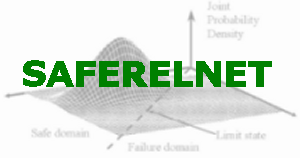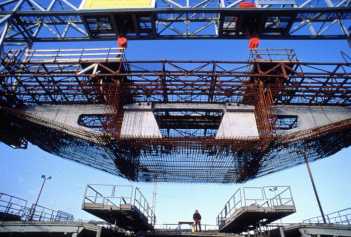 |
 |
 |
 |
| Thematic Network on Safety and Reliability of Industrial Products, Systems and Structures | |||
| terça-feira, 16 de dezembro de 2025 | |||
       |
| WP 5 - Reliability Based Design | ||||||
|
WP Leader: RCP Objectives The new developments of structural reliability methods will be reviewed, both the computational methods as well as the applications in specific studies and in code calibrations. Philosophy, objective and procedures for code calibration for traditional and new design concepts will be treated, as well as probabilistic codes and reliability based design by direct use of first principles. Further safety objective, risk acceptance and target reliability for structural designs will be addressed. Methods for reliability of existing structures, especially reliability updating via Bayesian methods, will also be reviewed and developed. Task 5.1 – Structural reliability analysis (SRA) Task leader: TUDelft In this task the best practices of SRA will be identified for the application in different industries. Also the typical application problems will be identified and described. Much progress has been made in time-invariant structural reliability methodology and a large variety of computerised methods for component and system analysis emerged. Among them are first-order reliability (FORM), second-order reliability (SORM), various schemes for importance sampling, response surface methods, various combinations thereof, etc. The advantages and field of application of those methods are to be reviewed and evaluated. Recommendations for practical applications are to be given. Those reviews also form the basis for the other tasks. Much less is available time-variant reliability. In essence, only the outcrossing approach can be used in practice. Then, the type of loading (or any other process disturbance) must be of (intermittent) vectorial rectangular wave renewal process type or of vectorial processes with differentiable trajectories or combinations thereof. For the stationary case FORM and SORM solutions are available. Non-stationary cases require additional numerical effort, which can be reduced substantially by making use of approximate asymptotic concepts. The state of the art is to be described and open questions are to be summarised. Applications to load combinations, accidental situations and deterioration such as fatigue and corrosion will be outlined. Work will also include practical examples and information on software. Also, in order to assure comparability and consistency of the results from SRA, guidelines for the modelling of the various uncertainties will be given. Task 5.2 – Reliability Based Optimisation Task leader: IPPT Direct application of time-invariant or time-variant reliability to structural optimisation is still under study. Several tasks can be identified. • structural optimisation with respect to direct cost (weight, volume, performance, etc.) under reliability constraints • structural optimisation with respect to reliability under cost (weight, volume, performance, etc.) constraints • structural optimisation with respect to cost including expected failure cost, possibly under additional reliability constraints. Reliability constraints can be given as probabilities or failure rates. Discounting of costs can be included or not. Also, different replacement strategies, e.g. no replacement after service or failure or systematic replacement after failure or obsolescence, can be adopted. As a general experience, optimisation requires a somewhat higher numerical effort. The methods investigated so far are: 1. alternating two-level schemes for the cost optimisation and the optimisation within the reliability part using SQP (sequential quadratic programming) 2. One-level optimisation with SQP using FORM or SORM for reliability 3. two-level optimisation using semi-infinite programming and an outer approximation scheme These methods will be reviewed and their merits and disadvantages discussed. The relevant software developments will be described. Also those types of practical problems which do not have a solution at present will be identified. Work will also include practical examples. Task 5.3 – Design by Codes Based on Reliability and Optimisation Task leader: PAFA The last 20 years have seen an advent of semi-probabilistic codes and codes for the basic concepts and definitions to be used in design. A fully probability based code is under development by the JCSS and in conjunction with the development of the so-called EUROCODES. Safety differentiation with respect to the consequences of exceedance of certain limit states has been proposed based on the concept that traditional codes are already optimal in some important design situations. This is not completely satisfying because the efforts to achieve safety (reliability) are taken into account only implicitly. The interaction of design rules and quality assurance procedures including quality control has been recognised. There is little to say about those attempts that in principle allow applying fully probabilistic methods. The next step in these developments certainly is towards optimal designs, which also would solve the target reliability problem. Here, the aspect of safety, i.e. the absence of a risk to human life and limb, is most important. Also, there is a close link to the concepts and methods applied in Task 5.1. A new approach will be discussed to determine how much should be invested into structural safety in code based design or in direct reliability oriented optimisation. This is based on a life quality index applicable to any public investment to save life years in suitable quality. Task 5.4 - Bayesian Reassessment of Structures Task leader: ETHZ Probabilistic modelling and updating of uncertain information. This task is concerned about probabilistic modelling of uncertain information in assessment problems. Physical uncertainties, model uncertainties and statistical uncertainties will be considered and treated specifically, however, under the same framework. It will be assessed and described how additional and or new information and knowledge may be used to update the models and appropriate calculation procedures will be identified. Uncertainty updating will be assessed and described specifically for the "generic assessment problem formulations" identified under task 6.1 in workpackage 6. |
||||||
| (Back) | ||||||
| Home | Overview | Structure | Workplan | Members | Meetings | Login |
| ©
2002 SAFERELNET Optimized for Internet Explorer 5+ |